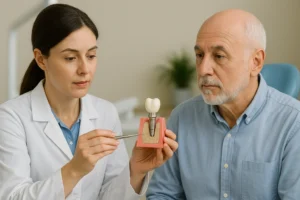Dental implants have revolutionized the way we approach tooth replacement, offering a durable and natural-looking solution. However, for some patients, the journey to a successful dental implant might include an additional procedure known as bone grafting. In this article, we will explore why bone grafting is sometimes necessary, the differences between a sinus lift and a bone graft, and what you can expect during the recovery process.
Bone grafting is a surgical procedure that involves adding bone or bone-like materials to the jawbone. This is essential when a patient does not have enough healthy bone to support a dental implant. Insufficient bone can be due to various reasons, such as prolonged tooth loss, gum disease, or natural bone deterioration.
Why is a Bone Graft Necessary for Dental Implants?
Dental implants require a strong and healthy jawbone to anchor the implant securely. If the bone is too thin or soft, the implant might not be stable, leading to potential failure. Bone grafting provides the necessary support and structure, increasing the chances of a successful implant.
Types of Bone Grafts
- Autografts: Bone is taken from another part of the patient’s body, such as the chin or hip.
- Allografts: Bone from a donor, usually processed to ensure safety and compatibility.
- Xenografts: Bone from an animal source, typically bovine, used after extensive processing.
- Synthetic Grafts: Man-made materials that mimic natural bone properties.
Sinus Lift vs. Bone Graft
A sinus lift is a specific type of bone grafting procedure used when dental implants are needed in the upper jaw. The maxillary sinuses, located above your upper teeth, can sometimes be too close to the jawbone, making it difficult to place implants. A sinus lift involves adding bone below the sinus, effectively lifting it to create enough space for the implant.
Key Differences
- Sinus Lift: Specifically targets the upper jaw and sinus area to accommodate implants.
- Bone Graft: Can be performed on any jaw area where additional bone is needed to support an implant.
The Bone Grafting Procedure
Pre-Procedure Evaluation
Your dentist or oral surgeon will conduct a thorough evaluation, including X-rays or a CT scan, to assess the condition of your jawbone and determine the best grafting approach.
The Procedure
Bone grafting is usually done in a dental office or surgical center under local anesthesia or sedation. The surgeon will make an incision in the gum to expose the jawbone, place the grafting material, and secure it with special membranes or screws. The gum is then stitched back in place.
Recovery and Healing After Bone Graft
Healing after a bone graft is crucial for the success of a dental implant. Here’s what you can expect:
- Initial Healing: Swelling and discomfort are common in the first few days. Pain relief medication and antibiotics may be prescribed.
- Ongoing Recovery: The graft needs time to integrate with your natural bone, which can take several months. Regular check-ups will ensure everything is progressing smoothly.
Tips for a Smooth Recovery
- Follow your dentist’s post-operative care instructions closely.
- Maintain oral hygiene but avoid the grafted area initially to prevent irritation.
- Avoid smoking and certain foods that can delay healing.

Success Rate and Costs
The success rate of dental bone grafting is generally high, particularly when performed by an experienced surgeon and followed by proper care. The cost of a bone graft for implants varies based on factors such as the type of graft used and the complexity of the procedure. Insurance may cover part of the cost, especially if the grafting is deemed medically necessary.
Who Needs Bone Grafting?
Bone grafting is not required for every dental implant patient. It is necessary for those with insufficient bone volume or density. Factors that might necessitate a bone graft include:
- Long-term tooth loss leading to bone resorption.
- Severe gum disease that has deteriorated jawbone structure.
- Developmental conditions affecting bone growth.
Conclusion
Bone grafting for dental implants is a vital procedure for ensuring the long-term success and stability of the implant. By understanding the need, process, and recovery involved in bone grafting, patients can approach their dental implant journey with confidence. If you suspect you might need a bone graft or are considering dental implants, consult with your dental professional to discuss your options and tailor a treatment plan suited to your needs.



